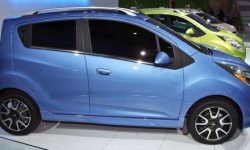Electric Vehicles have gotten a lot of media attention over the last few years. The United States, with the rest of the developed world, have made a push to reduce emissions and improve air quality in our cities. We use things like O2 sensors and Air Fuel Ratio sensors, along with catalytic converters, in order to reduce the impact that gasoline engines have on the environment. Recently, companies have been exploring ways to abandon gasoline consumption all together and produce “zero emissions” vehicles in the form of electric vehicles, like the Nissan Leaf. Although people have thoughtfully explored the impact of producing the electricity needed to charge the battery, all of the green-enthusiasts are conveniently looking away from the real issue: the lithium ion battery itself.
Lithium is a soft, silver-white alkali metal with the symbol Li on the periodic table. It does not occur freely in nature; it only appears in compounds that are usually ionic. Lithium salts are extracted from the water of mineral springs, brine pools, and brine deposits. The metal is then produced via electrolysis from a mixture of fused lithium chloride and potassium chloride.
The brine is usually pumped to large pools to let the sun evaporate the salts to a high enough concentration. Then this potent solution is pumped onto trucks and driven to processing facilities. Currently, 61% of the world’s lithium production occurs in Chile. Worldwide reserves of lithium are estimated at about 13 million tonnes. Using the battery efficiency figure of 400 g of lithium per kWh, this gives a total maximum lithium battery capacity of 52 billion kWh which, assuming it’s used exclusively for car batteries, is enough for 2 billion cars with the same size battery as a Nissan Leaf.
Problem is, only 25% of the world’s lithium goes into the manufacture of batteries (and that includes batteries for laptops and cell phones). Lithium is used for processing silica to make glass, as a major component in high temperature grease, in air purification systems, in nuclear weapons, and even in pharmaceutical drugs to treat bi-polar disorder. The world’s supply of lithium would be exhausted relatively quickly if we tried to run most of the world’s vehicles on lithium-ion batteries.
In response to this claim, many bring up the fact that Lithium batteries can be recycled, and thus diminishing the problem of depleting this rare metal. The problem with this is that lithium is rather volatile at room temperature, so the entire battery has to be cooled down to -345°F before it can be dismantled and recycled. Cooling batteries down to such extreme temperatures uses a tremendous amount of energy, reducing the favorable environmental impact lithium ion batteries are supposed to have.
In reality, with a rapidly expanding population and ballooning consumption of energy worldwide, there is no magic solution to solve our emissions problems and save the world. Continuing current habits of every individual driving and using inefficient means of transportation, along with the host of other issues with consumer culture, leaves little doubt that our current style of living is unsustainable. Save for the unlikely invention of cold fusion, we are going to have to re-evaluate the way in which we travel.





